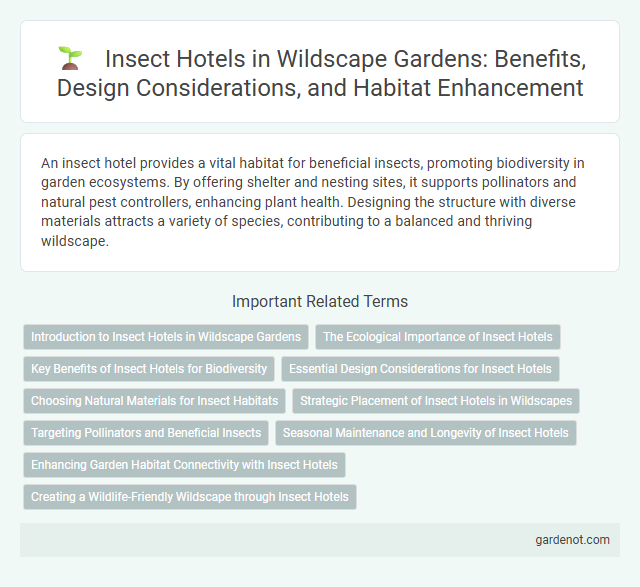An insect hotel provides a vital habitat for beneficial insects, promoting biodiversity in garden ecosystems. By offering shelter and nesting sites, it supports pollinators and natural pest controllers, enhancing plant health. Designing the structure with diverse materials attracts a variety of species, contributing to a balanced and thriving wildscape.
Introduction to Insect Hotels in Wildscape Gardens
In Wildscape Gardens, insect hotels provide essential habitats that support biodiversity by attracting pollinators and beneficial insects. These structures are designed with natural materials such as bamboo, wood, and straw to mimic insects' natural nesting environments. Incorporating insect hotels enhances ecological balance by promoting native species and improving plant pollination within the garden ecosystem.
The Ecological Importance of Insect Hotels
Insect hotels play a vital role in supporting biodiversity by providing shelter and breeding grounds for pollinators, predators, and decomposers essential to ecosystem health. These structures enhance natural pest control, improve pollination rates for wild plants and crops, and contribute to soil fertility through increased organic matter breakdown. Integrating insect hotels into wildscapes strengthens ecological resilience and promotes balanced, sustainable environments.
Key Benefits of Insect Hotels for Biodiversity
Insect hotels provide essential habitats for pollinators and beneficial insects, supporting biodiversity by promoting natural pest control and enhancing plant pollination. These structures create safe nesting and overwintering sites that help sustain insect populations crucial for ecosystem balance. Incorporating insect hotels into wildscapes encourages a healthier environment by increasing species diversity and resilience.
Essential Design Considerations for Insect Hotels
Insect hotels require careful selection of natural materials such as wood, bamboo, and straw to create diverse habitats that support various beneficial insects like solitary bees, ladybugs, and lacewings. The design must incorporate different sizes of holes and compartments, ensuring protection from harsh weather while maintaining adequate ventilation and drainage to prevent mold. Placement in sunlit, sheltered locations near flowering plants enhances insect activity and promotes biodiversity in garden ecosystems.
Choosing Natural Materials for Insect Habitats
Selecting natural materials such as untreated wood, bamboo, straw, and dry leaves is essential for creating insect hotels that provide safe and sustainable habitats. These materials mimic insects' natural environments, attracting solitary bees, ladybugs, and lacewings while offering shelter and nesting sites. Using locally sourced, chemical-free components enhances biodiversity and supports healthy ecosystems within wildscapes.
Strategic Placement of Insect Hotels in Wildscapes
Strategic placement of insect hotels in wildscapes enhances biodiversity by providing essential habitats near pollinator-friendly plants and water sources. Positioning these structures in sunny, sheltered spots ensures optimal microclimate conditions that attract beneficial insects like bees, ladybugs, and lacewings. Integrating insect hotels within diverse native vegetation corridors supports ecological balance and promotes natural pest control.
Targeting Pollinators and Beneficial Insects
Insect hotels designed for wildscapes provide essential habitats targeting pollinators such as bees, butterflies, and beneficial predatory insects like ladybugs and lacewings. These structures promote biodiversity by supporting the life cycles of key pollinating species and natural pest controllers, enhancing garden productivity and ecological balance. Materials like hollow stems, wood blocks with drilled holes, and dry leaves optimize nesting and shelter opportunities for these beneficial insects.
Seasonal Maintenance and Longevity of Insect Hotels
Seasonal maintenance of insect hotels involves regular cleaning and inspection to remove debris and check for mold or pests, particularly during fall and spring. Ensuring that the habitat remains dry and free from damage extends the longevity of insect hotels, promoting a stable environment for solitary bees, ladybugs, and other beneficial insects. Proper upkeep supports biodiversity and enhances the effectiveness of insect hotels in gardens and wildscapes year-round.
Enhancing Garden Habitat Connectivity with Insect Hotels
Insect hotels play a crucial role in enhancing garden habitat connectivity by providing essential shelter and breeding grounds for pollinators and beneficial insects. These structures support biodiversity by linking fragmented habitats, enabling insect populations to thrive and migrate safely across urban and rural landscapes. Incorporating insect hotels into garden design promotes ecological balance and improves pollination, which is vital for healthy plant growth and crop production.
Creating a Wildlife-Friendly Wildscape through Insect Hotels
Insect hotels provide essential habitats for beneficial pollinators and pest controllers, boosting biodiversity in a wildscape. Structuring insect hotels with varied materials such as bamboo, wood, and straw creates nesting options for solitary bees, ladybugs, and lacewings. These microhabitats enhance ecological balance, supporting plant health and promoting sustainable gardening practices.
Insect hotel Infographic

 gardenot.com
gardenot.com